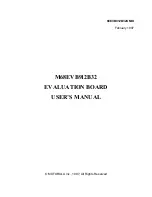
GENERAL INFORMATION
68EVB912B32UM/D
1-6
b. If D-Bug12 has been replaced in Flash EEPROM with user code (i.e., Mode 4
below has been performed), execution begins with the user program.
2. In JUMP-EE mode, execution begins directly at location $0D00 with the user code
in byte-erasable EEPROM.
3. In POD mode, the board makes use of the BDM OUT header (W12) and uses the
D-Bug12 commands to non-intrusively interrogate an external target MCU. Special
prompts are displayed to let the user know if this mode is selected. If no external
MCU is detected, the software informs the user.
The target’s EEPROM may be programmed while the host M68EVB912B32 board is
in EVB mode, using the D-Bug12 commands BULK, LOAD, FBULK and FLOAD.
4. In BOOTLOAD mode, the host EVB’s byte-erasable or Flash EEPROM may be
reprogrammed with user code. This mode may also be used to reload or customize
D-Bug12.
D-Bug12 allows programming of the MC68HC912B32’s on-chip EEPROM through commands
that directly alter memory. For details of all D-Bug12 commands, refer to 3.6 D-Bug12
Command Set.
When operating in EVB mode, the MCU must manage the EVB hardware and execute D-Bug12
in addition to serving as the user-application processor, there are a few restrictions on its use.
For more information, refer to 3.9 Operational Limitations.
1.4 EXTERNAL EQUPMENT REQUIREMENTS
In addition to the EVB, the following user-supplied external equipment is required:
•
Power supply — see Table 1-1 for voltage and current requirements.
•
User terminal — options:
−
RS-232C dumb terminal — allows single-line on-board code assembly and
disassembly.
−
Host computer with RS-232C serial port — allows off-board code assembly
that can be loaded into the EVB’s memory. Requires a user-supplied
communications program capable of emulating a dumb terminal. Examples of
acceptable communications programs are given in Appendix B
Communications Program Examples.
−
Host computer using the MCU’s BDM interface — frees the target MCU’s
SCI port for user applications. This requires another M68EVB912B32 for use
as the target or a background debug development tool, such as the Motorola
Serial Debug Interface (SDI).
•
Power-supply and terminal interconnection cables as required
Summary of Contents for M68EVB912B32
Page 8: ...CONTENTS 68EVB912B32UM D viii ...
Page 11: ...GENERAL INFORMATION 68EVB912B32UM D 1 3 Figure 1 1 EVB Layout and Component Placement ...
Page 22: ...CONFIGURATION AND SETUP 68EVB912B32UM D 2 6 ...
Page 80: ...OPERATION 68EVB912B32UM D 3 58 ...
Page 90: ...HARDWARE REFERENCE 68EVB912B32UM D 4 10 ...
Page 102: ...COMMUNICATIONS PROGRAM EXAMPLES 68EVB912B32UM D B 8 ...
Page 106: ...D BUG12 STARTUP CODE 68EVB912B32UM D C 4 ...
Page 112: ...D BUG12 CUSTOMIZATION DATA 68EVB912B32UM D D 6 ...
Page 122: ...INDEX 68EVB912B32UM D 4 ...





























